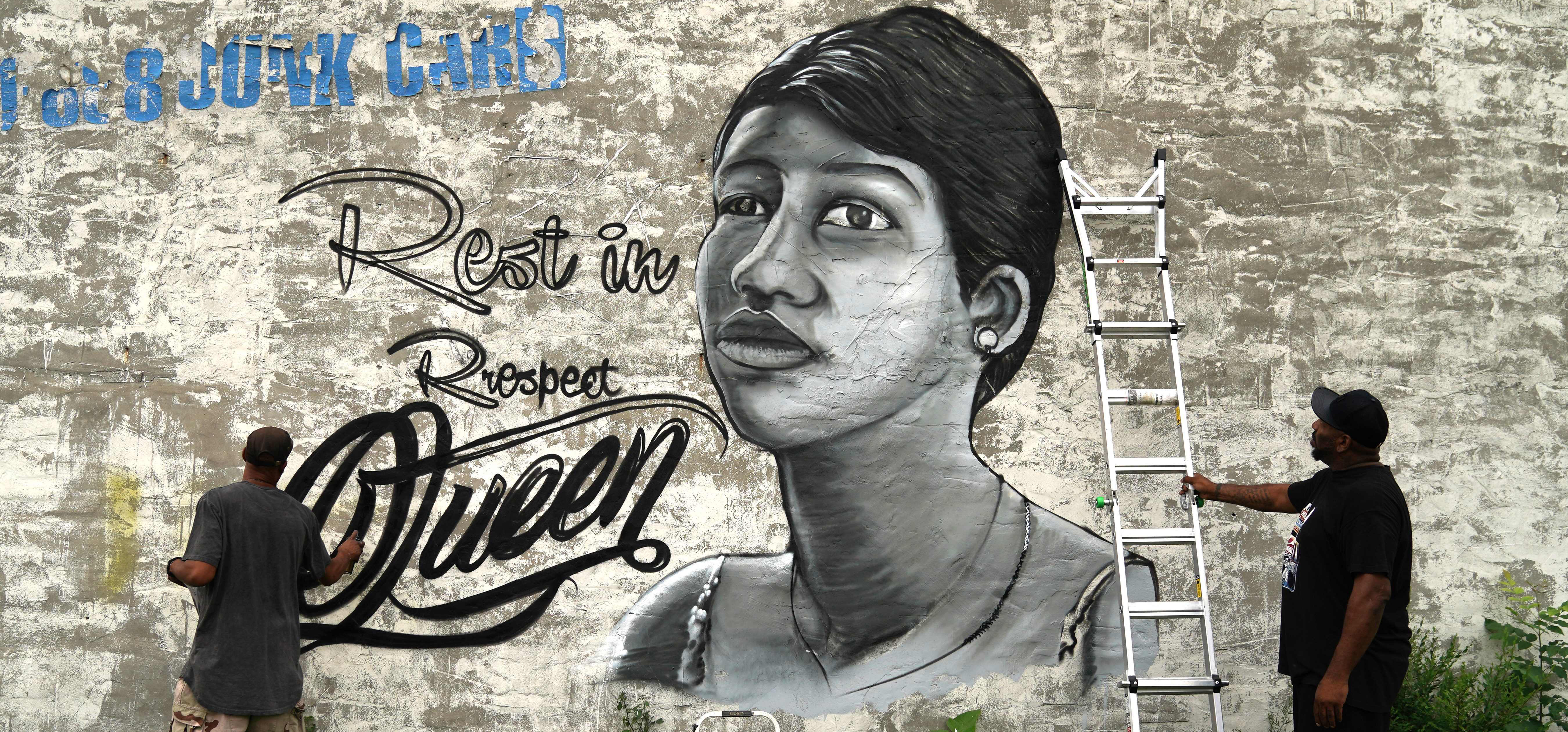
<p>A man paints a mural of Aretha Franklin on a wall down the street from where the Rev. Jesse Jackson spoke at a service celebrating her life. The service was held at her father's church, New Bethel Baptist, in Detroit, Michigan on August 19, 2018. (Photo by Timothy A. Clary / AFP / Getty Images).</p>
This post has been adapted from an essay published by the Stanford Social Innovation Review.
Last month, Senator Elizabeth Warren (D-MA) used a Detroit wall as a platform to highlight how discriminatory housing policies have divided our communities. The wall, six feet high and about half a mile long, was built in 1941 to segregate black homeowners from their white neighbors. It stands as a reminder of how inequitable access to housing was intentionally created through urban planning tools and policies.
Now planners, community activists, and residents are exploring ways to undo historic inequities by ensuring places are inclusive and provide opportunities for everyone. Placemaking is the practice of designing places that reflect the priorities of the community and foster a sense of belonging to improve residents’ quality of life.
Placemaking has been used to encourage investments in communities through targeted economic development while ensuring revitalization activities equitably benefit residents. Recent efforts in Detroit demonstrate how placemaking can not only promote local equity by putting the community’s needs first, but it can also tear down the barriers created by our nation’s discriminatory approach to housing.
What does history tell us?
Understanding the underlying challenges created by discriminatory policies and practices is key for proposing solutions that promote investment in communities, without displacing or pricing out families. For this to work, policymakers need to confront how housing covenants have promoted structural inequalities in US neighborhoods.
In 1934, the Federal Housing Administration guidelines incentivized lenders to reject borrowers in black neighborhoods, which fueled housing development in other areas that were most accessible to white residents. Mortgages were considered riskier not only based on income, but also on racial and ethnic composition. Black households seeking housing loans were denied, which formed racially segregated neighborhoods that perpetuated exclusion and poverty. This discriminatory practice, otherwise known as redlining, forced black families to buy homes in less desirable communities that lacked good schools, hospitals, open space, and other important community assets.
Although redlining does not formally exist today, black families have unequal access to homes in places with opportunities for them to thrive. The homeownership rate for black households is 43 percent, compared with 71 percent for white households. Lower investment in communities of color compounds this disparity.
How can placemaking address these challenges?
Effective placemaking can help undo the barriers created by discriminatory and inequitable policies. Placemaking can take many forms—developing equitable parks, installing art in less trafficked places, promoting walkability on main streets, and using other techniques to enhance public spaces.
Community involvement is key to decisionmaking around how to best use a place. Placemaking flips the top-down planning approach and embraces a participatory process that, although it may take longer, can be more rewarding.
Detroit, for example, has embraced placemaking’s potential for closing the equity gap in communities. Detroit’s racial equity gap is not as stark as in neighboring Chicago, and it is in the top 15 most racially inclusive cities.
City-led initiatives, such as Opportunity Detroit (PDF) and the West Vernor Corridor Neighborhood Framework, have contributed to this greater inclusion by targeting investments through placemaking in areas of blight and high vacancy to balance the resources flowing into the city. Both initiatives focus on transforming public spaces into community assets for residents and visitors by improving access to Detroit’s parks, such as Capital Park and Clark Park, improving mobility through streetscape redevelopment on Bagley Street, and linking destinations of interest.
The Clark Park Coalition has also worked with city agencies to ensure placemaking plans reflect community priorities by encouraging mixed-income housing construction and developing a public gathering place, inspired by Mexican zócalos.
These plans have strategically leveraged public, private, and philanthropic dollars to boost opportunities in neighborhoods of color and stimulate economic development. Revitalizing distressed areas around Detroit has helped grow more black-owned businesses and has reintroduced vibrancy in commercial corridors.
Initiatives such as the Strategic Neighborhood Fund have created channels for dedicating resources to improving community infrastructure and preserving housing affordability. These activities bolster community engagement and offer a platform for local planning leaders to make decisions based on community priorities.
Placemaking is helping close the racial inequity gap, but cities still have a long way to go. Catalyzing growth and strengthening local economies often comes with the threat of displacement, as households of color are typically the first to be priced out of a neighborhood.
But placemaking approaches help create balance by putting the community in the driver’s seat. With increased resources and capacities at the local level, neighborhood development can happen more equitably.
Today, homes on both sides of the Detroit wall are predominantly occupied by black residents. Community members and activists have painted a colorful mural to reflect the positive transformation of the neighborhood. But the wall also serves as a reminder of how our communities were built on historic inequities—and where thoughtful planning instruments are needed to tear them down.
Let’s build a future where everyone, everywhere has the opportunity and power to thrive
Urban is more determined than ever to partner with changemakers to unlock opportunities that give people across the country a fair shot at reaching their fullest potential. Invest in Urban to power this type of work.